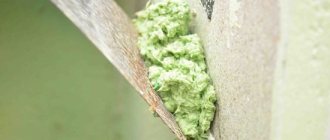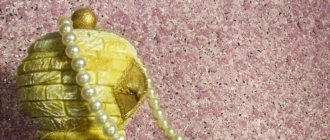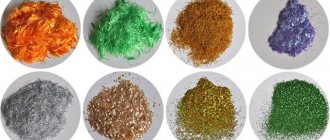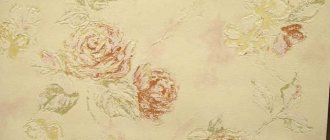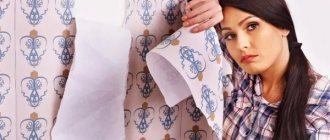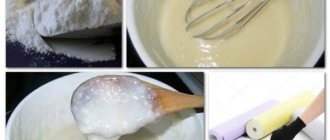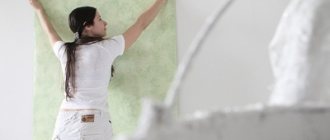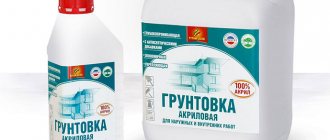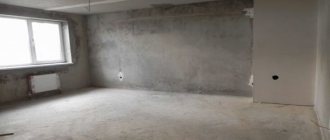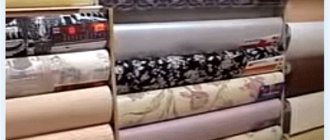Liquid wallpaper: composition, types, advantages and disadvantages
Repair work in a house or apartment almost always includes wall decoration. Liquid wallpaper can be considered one of the most flexible, environmentally friendly, safe and durable coatings. Many consumers are interested in what liquid wallpaper is made of
and whether it can be considered a type of ordinary paper wallpaper. The answer is obvious: liquid wallpaper cannot be considered wallpaper in the full sense. Most likely, this is a material intended for finishing walls or ceilings, which combines the best qualities of decorative plaster, paper wallpaper and paint coatings.
Liquid or wet wallpaper is a volumetric mixture consisting of water, cotton fibers, silk or cellulose and acrylic additives to add color. And the binder in this composition is glue. The mixture may also include sparkles of various diameters, pieces of mica, mother-of-pearl, mineral chips, threads and other materials. After application to the wall, the composition dries, holding all the components together and leaving an elastic coating on the surface.
Manufacturers
The quality characteristics of any product in the line of liquid wallpaper completely depend on the manufacturer. The main well-known brands include the following companies:
| Manufacturer | Product Description |
| Senideco (France) | A kilogram of the mixture, where the main component is cotton fabric, can cover 3.5 m2 of surface. Along with the brand's silk mixture, you can purchase decorative elements and a quartz primer. In addition, the product line also includes a base mixture for painting. |
| Silcoat (Türkiye) | Silk wallpaper from this company will last for 20 years without changing its original appearance. The coating can be wiped with a damp cloth without damaging the quality of the wall. One kilogram can cover up to 4 squares. |
| Wema (Germany) | The product line includes products based on cellulose and silk. One kilogram covers up to 3 m2. |
| Silk plaster (Russia) | The most popular and well-known brand that has been producing products for 20 years. The mixture is based on exclusively safe materials, for example, cellulose, textiles or silk fiber. |
Among Russian manufacturers there are many companies known on the world market for the quality of their products, which are not inferior in their characteristics to foreign analogues.
Have you already worked with liquid wallpaper? Share your impressions of the result in the comments!
What types of liquid wallpaper are there?
Depending on the type of filler, liquid wallpaper
may be of the following types:
- Cellulose - this variety is considered the most affordable option, as it has the lowest price compared to other types. Liquid wallpaper is based on a product of wood processing - cellulose; sawdust is also often used. This type of wallpaper is ideal for treating walls with small flaws, as it tends to hide them, and for creating a covering in unheated rooms. Cellulose liquid wallpaper is inferior in decorative properties to silk wallpaper and is less resistant to sunlight.
- Silk is a type of finishing material that is considered the most expensive and has excellent decorative qualities. The composition of such wallpaper includes silk fibers, thanks to which the coating on the surface of the walls looks like fabric wallpaper. This type of finish has increased wear resistance and does not fade in the sun. It can be applied to concrete, plasterboard surfaces that do not have large cracks.
- Cotton is a liquid wallpaper that contains cotton. They are an environmentally friendly and hypoallergenic finishing material. This coating is very warm and pleasant to the touch. In addition, to obtain a varied texture, mica impurities, various decorative additives, and cellulose are added to the mixture.
- A mixture of cellulose and silk fibers - this type of liquid wallpaper is considered the “golden mean”, since it occupies an intermediate place in the price category. The mixture may also contain cotton fibers, as a result of which the coating is quite elastic and attractive in appearance.
Depending on the initial state, liquid wallpaper is divided into two types: dry powder, packaged in bags, and material in a liquid state. The dry mixture contains all the necessary elements in its composition, and the consumer only has to dilute it in a container with water. The powder package includes detailed instructions on how to use the mixture. One package is usually enough to cover a wall surface area of 3 to 5 square meters. And for those who will be using liquid wallpaper for the first time, the second option is preferable, since the mixture is already completely ready for application. But no matter what types of liquid wallpaper
purchased, special rollers, spatulas or sprayers are used to finish the walls.
What properties does the material have?
Liquid wallpaper contains natural components that have an excellent antistatic effect and good fire resistance. This type of finishing material has excellent heat and sound insulation properties. It can be used to hide surface unevenness or even large damage due to its plasticity. Liquid wallpaper is often applied even to pipes and radiators that are pre-coated with insulating material, as a result of which the material prevents rust.
Advantages and disadvantages of wall finishing material
Like any other material intended for finishing the surface of walls or ceilings, liquid wallpaper has its advantages and disadvantages. The indisputable advantages of the coating include the following:
- The mixture, presented in the form of a dry powder, is very easily diluted with water, and you don’t even need to use a mixing attachment for stirring, but do everything by hand;
- All types of coatings are environmentally friendly, safe for people and can be used, including for finishing a child’s room, and used in educational and medical institutions;
- Unlike paper wallpaper, liquid wallpaper forms a seamless coating and when applied there is no need for joining or adjustment in the corners of rooms;
- You can optionally add various additives to the mixture, for example, compounds that prevent the appearance of mold, mildew, etc.;
- The service life of the material is practically unlimited;
- Even an unskilled worker with no experience can handle applying the solution to the wall;
- If, over time, the coating on a certain section of the wall needs to be repaired or replaced for some reason, this can be done easily and almost imperceptibly;
- This material allows you to decorate walls in an original way and to your taste due to its excellent plasticity, for example, to apply patterns or make panels;
- Dismantling wet wallpaper also does not take much time and goes quickly, without disturbing the base of the walls;
- The removed coating can be used for reapplication;
- Compared to some other materials for wall decoration, liquid wallpaper, even silk, is much cheaper;
- Due to its high elasticity, liquid wallpaper is widely used by designers to create three-dimensional designs, intricate patterns and even paintings;
- Liquid wallpaper can be combined with other materials, such as photo wallpaper, ceramic tiles, artificial and natural stone to create a specific effect.
Speaking about the disadvantages of wet wallpaper, it is worth noting that there are not many of them. The disadvantages of the finishing material are the following:
- The coating is not moisture resistant and may therefore deteriorate if exposed to water. For this reason, it is not recommended for use in the bathroom or kitchen. However, if you add special protective additives to the prepared mixture or apply colorless acrylic varnish in several layers over the dried finish, you can get a washable decorative surface.
- The relief texture attracts dust and promotes its settling. But this drawback can be easily eliminated if you regularly carry out dry cleaning and clean the walls with a vacuum cleaner.
- The color scheme is pastel tones, there are no bright accents;
- It is better to apply wet wallpaper on a slightly rough surface, since on a very smooth surface the coating may simply run off.
Pros and cons of coverage
Experts highlight a number of positive aspects and features of this finishing material. The list of advantages includes several properties:
- Environmentally friendly (made from natural materials that do not harm health or the environment).
- Repairability (they can be reapplied to the defect site. The main thing is to maintain the standard shade; it will be easier to repeat the structure).
- Fire resistance (have a low ability to maintain a flame, generate smoke, exclude flammability and combustibility).
- Simplicity (work requires a minimum set of construction tools, no special qualifications are needed).
- Antistatic (during operation, complex maintenance and regular cleaning are not required, since dust and other contaminants are not attracted).
- Heat and sound insulation (decorative finishing has a positive effect on the indoor microclimate and serves as a barrier to sound penetration).
- Resistance to ultraviolet rays, frost (in poorly heated rooms, after prolonged exposure to the sun, the color or technical characteristics will not change).
- Warranty period (material with good operating characteristics: service life - 7-10 years).
Based on all the positive aspects, liquid wallpaper will last a long time. But the material also has disadvantages. The disadvantages of the popular finish include:
- Absorption of pigments (any stain under the decorative layer gradually appears on the wall if the surface is poorly prepared).
- Long drying period (up to a week, although the total period depends on the air temperature, season, and frequency of ventilation).
- Tendency to deformation (under the influence of strong mechanical stress they can be scratched or torn, but this disadvantage can be corrected quickly).
- The ability to absorb water (they cannot be washed, but their maintainability allows you to quickly level the surface of the walls and eliminate defects).
- Maximum permissible humidity - it is not recommended to cover walls in the bathroom or kitchen with such compounds or additionally treat them with transparent varnish (how to choose and hang wallpaper in the kitchen?).
Advice
If we compare the advantages with the disadvantages, then there are clearly more advantages. Therefore, liquid wallpaper still remains a practical material for repair work: any defects or damage can be quickly corrected.
We invite you to watch a video about the advantages and disadvantages of liquid wallpaper:
How to prepare the mixture for application?
In order to dilute the powder and prepare wet wallpaper for application to the surface, you need to perform the following steps:
- Pour the powder into a deep container and fill it with warm water. Water temperature - no less than 30 and no more than 35 degrees. The fact is that if you pour the mixture with a very hot liquid, it will become unsuitable for application, and if it is too cold, the process of preparing the solution will be delayed.
- Using a mixing attachment and a screwdriver, mix the solution. In addition, a fairly common option for preparing the mass is to knead the powder with your hands until you obtain a homogeneous consistency, somewhat reminiscent of minced meat.
- The solution should stand for 10-15 minutes, and then begin finishing the walls.
Before preparing the solution, be sure to read the instructions and follow all the manufacturer’s instructions. The instructions indicate how much water, depending on the composition, must be added. Many consumers find it convenient to stir the mixture in a plastic bucket with their hands. There is no need to be afraid that the solution will have a negative effect on the skin: it does not contain chemical additives, which means there will be no irritation on the skin. Some manufacturers recommend putting the finished mass back into the bag, tying the neck and leaving the solution for several hours (at least 4) for uniform swelling.
How to use
The packaging usually contains instructions for preparing the mixture and basic recommendations for applying to the surface.
The algorithm of actions is quite simple:
- The mixture should be diluted in the manner indicated on the label, observing the proportions and stirred until a homogeneous mass is obtained.
- Leave to brew for 12 hours.
- Stir the substance thoroughly before use.
- Prepare a spatula for uniform application.
- Each surface should be coated with a mixture of one portion to avoid unevenness and visible transitions.
The composition is applied to the wall in a circular motion. It is better to start application from top to bottom. The first layer is laid with a thickness of 2-3 mm, the second no more than 2 mm. The overall thickness of the overall layer should not exceed 4-5 mm. Wallpaper drying time is on average 3 days.
Before using liquid wallpaper, you need to clean the walls of the previous coating and prime them twice. It should be noted that they are easier to cover rough surfaces. Smooth ones can run off. For a more textured finish, the mixture can be applied with a stiff hair roller.
When creating the composition of liquid wallpaper with your own hands, use PVA glue.
Where to apply this finish
The composition is endowed with a plastic texture, which makes it possible to easily apply it to surfaces of complex shape (arch, column, fireplace niche). Sometimes the ceiling is covered with this composition. Liquid wallpaper is used to decorate living rooms in an apartment. The use of liquid wallpaper in the kitchen and bathroom is also possible, but taking into account the high level of humidity and the likelihood of severe contamination of these rooms.
Is it possible to make liquid wallpaper yourself?
Liquid wallpaper is a type of finishing coating that you can make yourself. The composition of the homemade mixture is quite simple. To prepare it, you will need old waste paper, for example, newspapers, magazines, pieces of old paper wallpaper, various dyes, PVA glue, water, pieces of mica, sawdust, mineral chips, and various additives to create an unusual texture. And in this case, the choice depends solely on the taste preferences of the home owner.
The process of preparing the solution with your own hands does not take much time and is quite simple. So, how to make liquid wallpaper yourself?
First, water is poured into the container, and then finely chopped paper is placed and left for a while so that it is well saturated and sour. Then, using a drill and a mixing attachment, the components are mixed until a homogeneous mass is obtained. Then glue, dyes and decorative additives are added to the solution. The mixture is thoroughly mixed, and gypsum is added last. It is not recommended to prepare a large amount of the mixture at one time, as it begins to thicken during application. Before the solution hardens, it is necessary to completely develop the finishing material.
In addition, when making homemade wallpaper mixtures, cotton and cellulose fibers, such as cotton wool or wood cellulose-based insulation, are often used. Wool, twine, and flax fiber can also be added to the composition - all this affects how the liquid wallpaper on the wall will ultimately look.
Of course, a mixture prepared at home yourself is a very budget-friendly option for liquid wallpaper. But this material has some disadvantages. If you neglect the technology for preparing the solution or use low-quality components, the finish may peel off or lie on the surface in lumps.
How to apply liquid wallpaper: videos and recommendations
1. Preparation for applying liquid wallpaper is a rather time-consuming process. This is due to the fact that wallpaper is sold dry and needs to be soaked to a certain consistency. This is not difficult to do: pour the contents of the package with liquid wallpaper into any plastic container, it can be a bucket or bowl, whichever is more convenient for you, and fill it with warm water.
The amount of water is always indicated on the packaging - and it must be strictly observed in order to obtain exactly the desired thickness of the finished mixture. It is also important to monitor the temperature of the water used to spread the wallpaper; it should be warm, but not hot, approximately 45 degrees.
After adding warm water to the dry mixture, stir it thoroughly. This must be done carefully, carefully and slowly.
It is not recommended to use a construction mixer for these purposes, since mixing too quickly will inevitably damage large fractions of the dry mixture, and this will lead to a disruption in the final appearance of the finished coating.
The mixed consistency must be covered with a lid or film in such a way as to prevent the evaporation of water. It is necessary to allocate at least eight hours for soaking, and possibly more.
When soaked, liquid wallpaper can be stored for up to five days, and during this time it will not lose its adhesive or other properties.
Immediately before use, the finished liquid wallpaper must be carefully mixed, achieving a uniform consistency. The finished mass is viscous and plastic, it has an adhesive structure of medium thickness.
2. Prime the walls. Be sure to prime the walls before applying; what kind of primer to use was described above.
3. Application of liquid wallpaper. First of all, it is worth noting that the process of applying liquid wallpaper is quite simple and can be done by any novice specialist, even those who have never done this before. Roughly speaking, the point of treating the surface with wallpaper is to apply it and distribute it evenly over the entire surface.
To apply, take a medium or wide spatula, or you can use a plastic grater. Here, it is advisable for everyone to choose a tool to their own taste and evaluate the convenience of each of them. The main task of the master is to obtain approximately the same layer of finishing material on the surface. Correctly distribute the wallpaper in a straight line, in any direction, trying to ensure equal pressure on the tool. It doesn't matter whether you move it in the same direction, but be careful not to make circular movements, as such a step can ruin the texture of the finished wallpaper.
The thickness of the wet layer immediately after application should be on average about 2 millimeters; if you make the layer thinner, bald spots may appear after drying; if it is too thick, there may be problems with leveling on the surface. A thicker layer may be justified if there are level differences of more than two millimeters on the wall being treated. As the wet solution dries, the wallpaper shrinks along the wall, and the layer becomes thinner - this circumstance should be taken into account when applying the product.
While working, you need to be careful and try to distribute the wallpaper using approximately the same movements, adjusting the pressure. At the end of each stretching motion, the float or spatula should come off the surface on which the wallpaper is being applied.
It is important to observe one more condition: one continuous surface must be treated with one mixed portion of liquid wallpaper. This will allow you to maintain the same texture pattern and shade on the entire surface from one corner to the other.
If there is an urgent need to interrupt work in the middle of the wall, then when starting to apply liquid wallpaper the next time, you will need to soak the free edge of the applied wallpaper with water - in this case, it will be possible to maintain the similarity of color and texture.
In the process of distributing liquid wallpaper, it is useful to ventilate the room - air flows perfectly contribute to the evaporation of moisture from the mixture and its rapid drying. If the ventilation process is difficult, then it is possible to use fans with warm air - they can be directed directly at the freshly treated surface.
You can apply liquid wallpaper in one layer or layer several layers of different colors - this will give an unusual texture and original design.
By the way, if you are interested in finding out what happens if you apply liquid wallpaper to paint, you can watch the video
How is liquid coating applied?
In many ways, the technology for applying liquid wallpaper to the surface of walls is similar to finishing with decorative plaster. Therefore, consumers who want to know how to glue liquid wallpaper
must be able to properly use any dry decorative mixtures.
The first thing you need to do is prepare your working tools and materials: ready-made mixture, trowel, rollers, spatulas, rags, stepladder, water. When applying the mixture to the wall, it is important to adhere to some rules:
- A layer of mortar is laid along the entire length of the blade of a wide spatula and then rubbed over the surface of the wall;
- The finishing material should be applied to the walls from the middle from the ceiling itself and then move to the sides from the center;
- To finish the corners, use a narrow spatula;
- If the layer is applied too tightly or there are some flaws, this area is cleaned off and the solution is applied again;
- In order to reduce the consumption of liquid wallpaper, you can pre-paint the walls to match the finish coat, and if the liquid wallpaper is transparent, the flaws will not be so visible.
It is convenient to apply the solution using a trowel with a transparent plastic working surface. This method will allow even beginners to distribute the mass on the wall surface without any flaws. First of all, you need to apply the soaked composition to the surface, and then rub it on the wall in a circular motion. Then place a new batch of material on the plane and continue working from the previous place.
At the same time, the most economical way to apply wet wallpaper is to use special sprayers. This allows you to get an even layer of small thickness. You can also apply the mixture with a roller and get original design solutions as a result.
If you plan to decorate a wall using various panels or patterns, then the decoration includes creating an outline of image fragments on the wall using a pencil and felt-tip pen. If necessary, bright acrylic and oil paints are applied to the designated areas as a base, and then liquid wallpaper is applied on top of them. The boundaries of the drawing are adjusted using a spatula.
Briefly about application technology
The sequence of the process of sticking liquid wallpaper on walls with your own hands is quite simple:
- First, the silk plaster itself is prepared. Having kneaded the composition, it is hermetically sealed and left to mature.
- Prepare walls, ceilings, partitions.
- Separate part of the finished mass for work (the rest is sealed again). Apply the solution to the wall and level it, moving from the most illuminated corner of the wall to the darkest one.
- Once application is complete, allow the finish to dry naturally.
Preparing the walls
The walls are freed from inappropriate old finishing (wallpaper, whitewash, peeling paint, deteriorated plaster). Repair damage (cracks, chips). Clean off stains, dry, coat with primer twice. This issue is discussed in more detail in a separate article.
When applied, the painted composition may get onto adjacent areas of the wall and leave an “indelible mark.” Therefore, untreated nearby surfaces are protected with film or masking tape.
Application
Homemade silk plaster is applied only by hand using plastering tools. The application method is similar to that practiced by plasterers. It is possible to apply a layer from 2 to 10 mm. During application, the evenness of the surface is checked visually, using counter light from a source close to the wall.
Experience shows that it is not at all difficult to make liquid wallpaper for walls with your own hands. Of course, there is more hassle in this case than with purchased mixtures, but the cost of “homemade” finishing is several times less. And the pleasure from the process of decorating your apartment yourself is much greater.
Additional videos on making liquid wallpaper with your own hands.
How to repair the coating?
Often, in certain areas of the wall, liquid wallpaper is damaged or dirty. If the material is not secured with a clear varnish that can be washed, then damaged areas will have to be replaced. You need to keep this in mind and leave a certain amount of dry mixture in stock in advance, or purchase a new one in the store that is suitable in texture and shade.
Damaged areas can be repaired very quickly. Places with damage should be circled with a simple pencil and these fragments should be moistened with water. Then, when the areas of the coating have softened, carefully remove the liquid wallpaper using a spatula. If the base of the wall is damaged, it can be puttied and primed. Then a small amount of dry mixture is diluted and a “patch” is applied to the prepared surface. As a rule, this method of repair leaves no traces behind and the finishing coating completely takes on its previous appearance.
As for reusing liquid wallpaper, this is also possible without any problems. If there is a need to transfer liquid wallpaper or replace the coating with another type of finish, then the wallpaper is first sprayed with water. Then, when they are wet, the layers are carefully removed with a spatula. In this case, the base of the wall is practically not damaged, and the removed material can be dried and reused. The main thing is to store it in closed containers or plastic bags in a dry place.
Advantages
Using liquid wallpaper, you can make partial repairs; to do this, just clean a piece of the surface from the old ones and apply a new composition to this place. The advantage is that you don’t have to select a pattern, since there are no seams when covering walls with liquid wallpaper. The description of the benefits looks like this:
- They have a matte surface that is pleasant to the touch.
- Liquid wallpaper aligns corners well, so use in disproportionate rooms is justified.
- Wallpaper is elastic, so it easily fills cracks that appear over time as houses shrink.
- Such coatings allow you to implement various interesting wall decor ideas: paintings, panels, drawings.
- The porous structure of the wallpaper absorbs the moisture that is formed and releases it when necessary in a dry room. In addition, the canvases have high sound and heat insulating characteristics.
You should not use this wallpaper on the walls of a room with high humidity, or in an apartment with pets. If the area is damaged, it will be difficult to choose the same shade for the patch, so it is better to have additional materials.
How to care for liquid wallpaper?
Due to the fact that liquid wallpaper easily gets wet when it gets wet, cleaning with detergents is completely excluded. This is only possible if the surface of the walls is varnished or has a protective film. But we must keep in mind that after such treatment the wallpaper loses its valuable property - vapor permeability. In general, it can be noted that liquid wallpaper does not require special care. During operation, they can be easily cleaned of dust using a vacuum cleaner. If there are any minor stains, you can try to remove them with a regular eraser.
What it is
The unusual finishing material is considered something between decorative plaster and paper wallpaper. It managed to combine seemingly incompatible properties. Perhaps that is why it is also called silk plaster. Explaining what liquid wallpaper is is quite difficult. This is a plastic mass based on cellulose, which is applied to the walls in a thin layer like putty paste.
The result is a very beautiful coating that resembles soft felt or fabric. Depending on the additives, its texture can vary significantly. The properties of the plastic mass are such that you can literally paint on the walls with it in different colors.
Instagram wallpaper_zhidkie_yk
Masters create multi-colored panels, lay out similar bas-reliefs, or decorate walls with monochrome and multi-colored patterns. The material makes it possible to realize any idea
- Decoration Materials
How to remove liquid wallpaper from a wall manually and mechanically
